Spiegelhalter's: The ultimate symbol of holding out
- Published
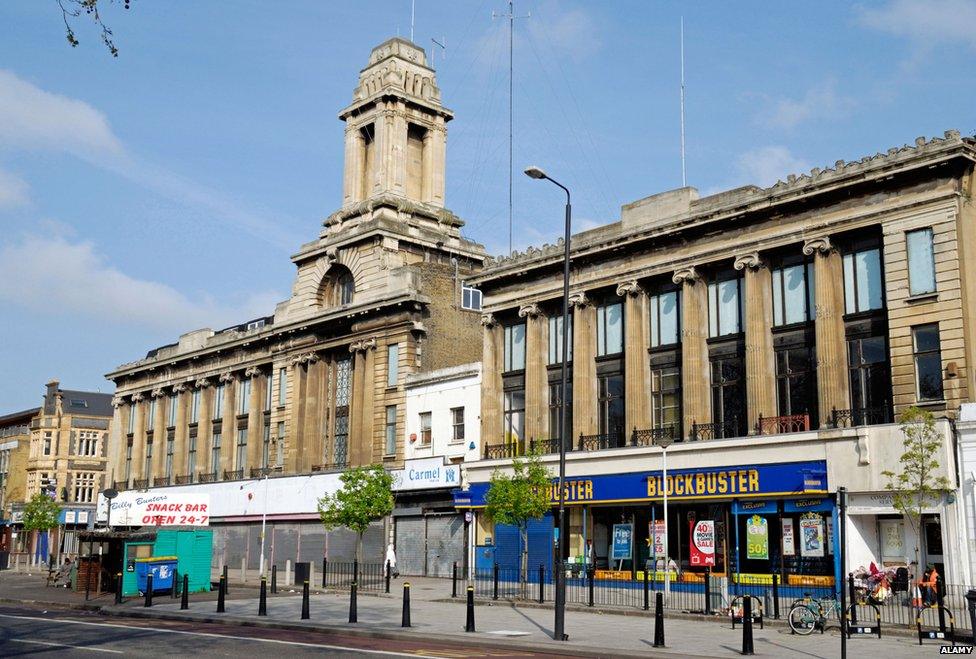
The former Spiegelhalter jewellers in 2009
A shabby old shop that became an architectural landmark has evaded the bulldozer for a second time - almost 90 years after its first escape. Spiegelhalter's is the British equivalent of the Chinese "nail house".
It's a popular theme in movies and television. A plucky home or business-owner refuses repeated offers from a bullying property developer.
In China, it's now a frequent occurrence. Images circulate of lone buildings surrounded by rubble or where the developers have gone ahead and built around them. They are known as "nail houses" because they refuse to be hammered down.
Some owners go to extraordinary lengths to keep their properties intact, even as skyscrapers and shopping centres rise above them and roads are planned to run through them.

A nail house sits in the middle of a road under construction in Nanning, China
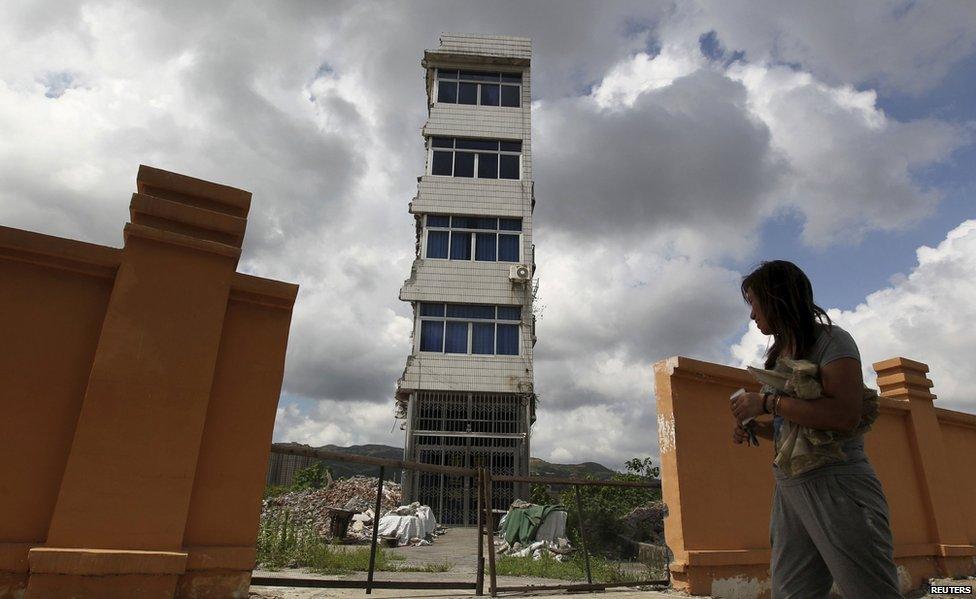
A partially demolished nail house in Rui'an, China
But they have their precursors in "holdout" buildings in the US and an extraordinary example from London.
Its tatty 19th Century frontage is dwarfed by the neoclassical superstore that stands either side of it. It might be small, but what's left of the Spiegelhalter jewellery and clock shop is a symbol of defiance.
The shop in east London's Mile End Road survived an attempted demolition in the 1920s - thanks to its owners' stubbornness. The Spiegelhalters' neighbouring business, Wickham's Department Store, had grown until it owned several buildings on either side.
It made an offer to buy out the Spiegelhalters - in business in Mile End Road since the early 19th Century, having migrated from Baden - and knock down their shop. The plan was to build grander premises, complete with columns and a tower, with the explicit aim of rivalling Selfridges, the famous West End department store.
But the Spiegelhalters, who had already moved from 75 to 81 Mile End Road in 1892 to accommodate an earlier stage of the Wickham's expansion, resisted this time. No offer would budge them, meaning the department store had to be built around their shop. This made the store asymmetrical, as its "central" tower had to be moved to the side.
Now nine decades later, the little shop in the middle of a grand new development has again escaped destruction.
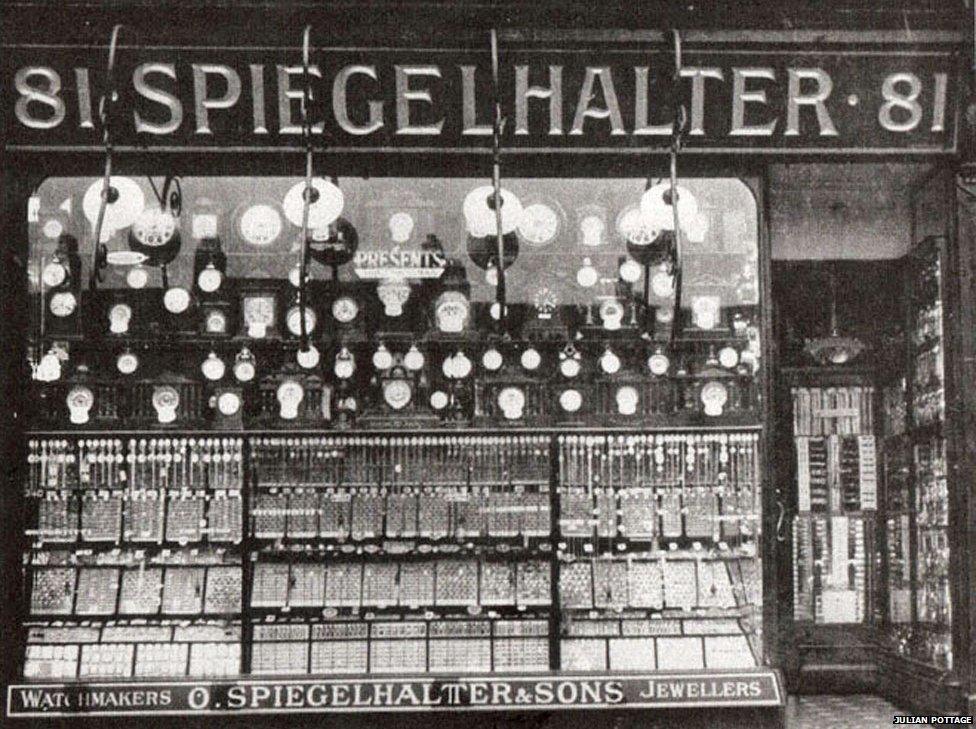
Spiegelhalter and Sons in about 1900
More than 2,700 people signed a petition to keep what remains of the frontage, external, described by the famous architecture critic Ian Nairn in the 1960s as "one of the best visual jokes in London". The developers have listened and, instead of going, the first floor of the Spiegelhalter shop will now form an archway over the entrance to an office and accommodation complex.
"It's important we keep individual buildings in place, so people don't feel a sense of dislocation," says Harriet Harriss, principal lecturer in architecture at Oxford Brookes University. "Much of modern development in London and elsewhere looks the same. It could be anywhere. It would have been ironic if Spiegelhalter's, a building that Hitler couldn't destroy during the Blitz, was removed forever now."
The incongruous Spiegelhalter shop became a landmark. In his 1966 book Nairn's London, external, regarded as a classic of topographical writing, Ian Nairn described it as "a perennial triumph for the little man, the blokes who won't conform. May he stay there till the bomb falls."
"It's at the level of the pedestrian facade where buildings are the most distinct," says Harriss, "showing regional differences and telling us stories about the way places have changed. If we get rid of that, we lose a lot of our cultural heritage."
The Wickhams eventually sold up, as department stores became less viable. The Spiegelhalters held on until 1982, their building becoming an off-licence after they left.
Since the 1990s, both sites have been in common ownership. Tesco Metro and a Sports Direct rent the ground floor of the old department store's premises. The Spiegelhalter shop, of which only the first-floor facade remains, is no longer in use.
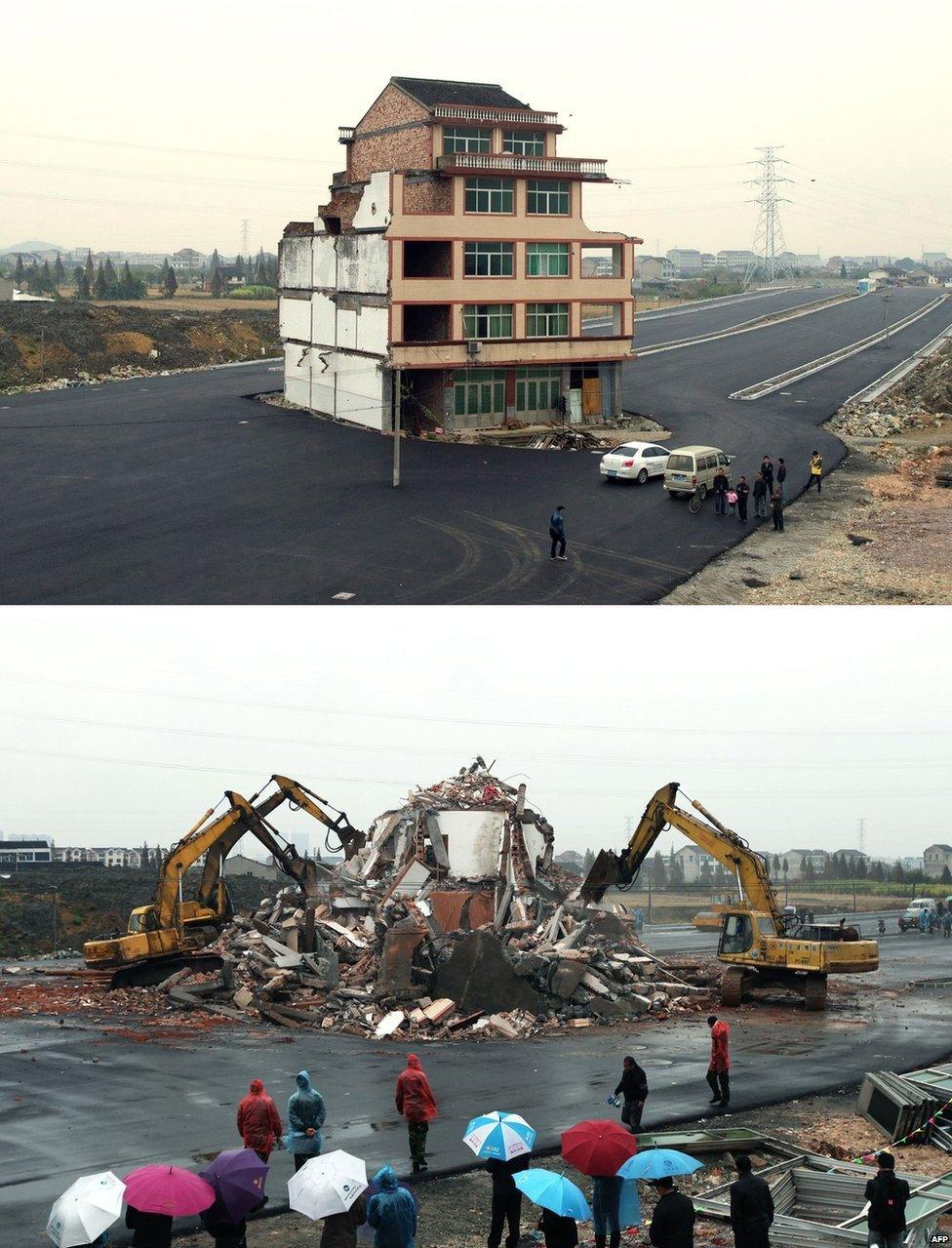
Before and after - excavators tear down a five-storey apartment block in the middle of a newly-built road in Wenling, in eastern China
Plans have been submitted to Tower Hamlets Council to renovate the Wickham's building. But a petition, backed by English Heritage, the Twentieth Century Society and the Victorian Society, protested against proposals to remove the remainder of the Spiegelhalter shop to allow a tall, glass-fronted atrium.
Following the campaign, architect Buckley Gray Yeoman says it will change the plans so that the Spiegelhalter's frontage will remain, forming an archway above the main entrance. Director Matt Yeoman has said the company wants to listen to concerns, external, rather than behave in an "arrogant" manner. However, he added that it made the project a "slightly missed opportunity to create something more interesting".
The council says it is "keen to retain the heritage of the building" and is "working closely with the applicant to explore how to do so". "We hope that amended plans will be submitted in the near future," a spokeswoman adds, "and if so these will be published for further consultation with the local community."
"It's important that developers listen to what the public is saying, rather than making it a David-versus-Goliath contest," says Joe O'Donnell of the Victorian Society. He thinks the preservation campaign "evokes the spirit" of what the Spiegelhalters did in the 1920s. "Keeping the frontage is no hindrance to the architects' design, while it preserves a valued part of the streetscape."
In other parts of the world, where rampant redevelopment has meant the displacement of families and businesses on a bigger scale, some strain to achieve the same as the Spiegelhalters did in the 1920s.

A three-storey nail house in the middle of a road in Luoyang, China...
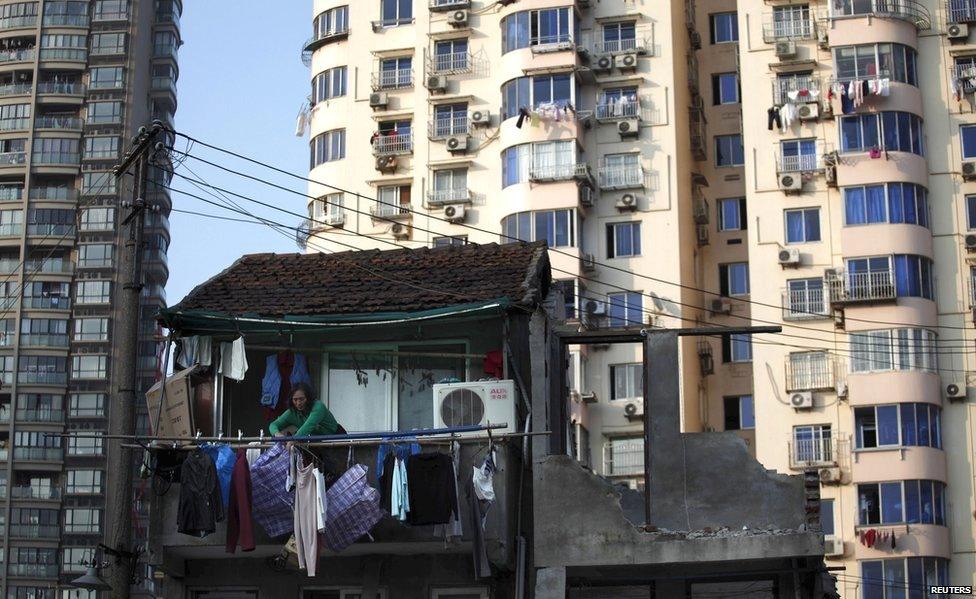
And one surrounded by tower blocks in downtown Shanghai
China provides stunning examples of holdouts, external. One house was left standing on a mound of earth in Chongqing for three years until it was demolished. Another remained standing in the middle of a shopping mall in Changsha. And one stayed in place despite being in the path of a road in Zhejiang province.
Chinese developers are said to call such properties "nail houses", external, as they liken them to stubborn nails that can't easily be hammered into wood. People in the country have had stronger property ownership protections since 2007, external, increasing the potential for conflict.

A nail house sits on top of a mound next to a construction site in Yibin, China

Chinese workers build around a grave mound 10m high, at a construction site in a village in Taiyuan
Most attempts to prevent demolitions fail but the nail houses have become a "powerful symbol of resistance", according to The Atlantic, external, some of their owners carrying on the fight for years and gaining widespread media coverage. Councils are said to cut access to utilities to encourage owners to leave, or even to demolish homes when they are out, external for the day.
There have been several prominent cases in the US. In 2006, octogenarian Edith Macefield became famous for refusing to sell her Seattle bungalow for $1m (£650,000) to make way for a development. So it had to be built around her home. But she died in 2008 and it was recently put on sale.
Passers-by have taken to attaching balloons to the fence in front of the building, external. This is a reference to the 2009 Disney film Up, in which pensioner and widower Carl Fredricksen resists the developers.
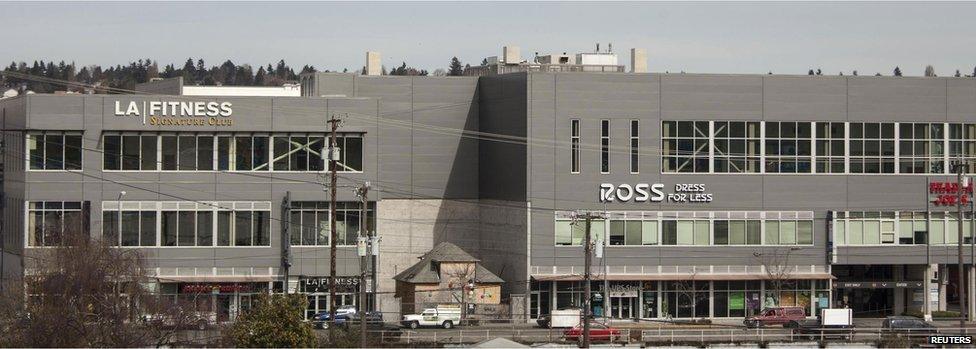
The house formerly owned by Edith Macefield in Seattle
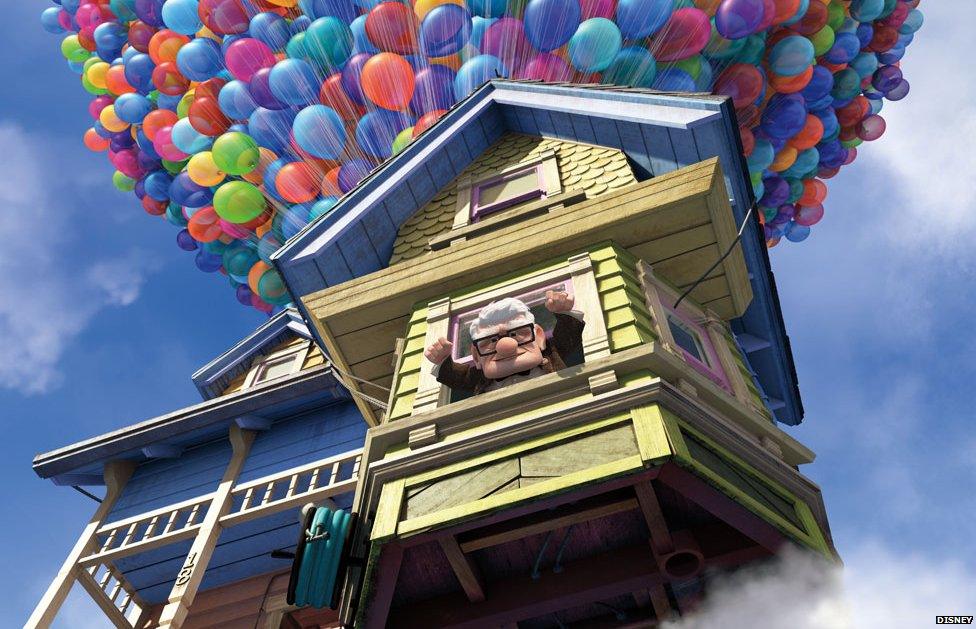
In Up, a pensioner escapes developers by tying balloons to his house and floating off
The corner of the block housing Macy's department store, external in New York has been a holdout for more than 100 years, the shop's owners never being able to buy the five-storey building there. Macy's sometimes rents advertising space on its front to hide the anomaly.

Macy's has covered its corner building with a giant shopping bag
The Spiegelhalter facade looks set for a prouder future.
"It's rather sweet," says historian Ellen Leslie. "It's a real one-off." But she warns against a movement towards "facadism", arguing that it's important to maintain buildings in their entirety. "You don't want to keep just the front and have a load of glass and steel at the back. That's not what our heritage is all about, and developers should be made aware of that. But, as hardly anything of Spiegelhalter's remains anyway, the decision here is good news."
It remains a talking point, just as Nairn would have wanted.
Subscribe to the BBC News Magazine's email newsletter to get articles sent to your inbox.